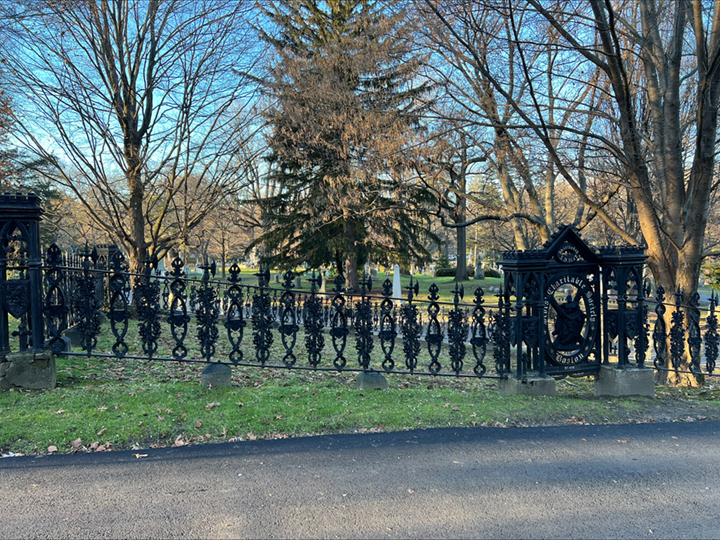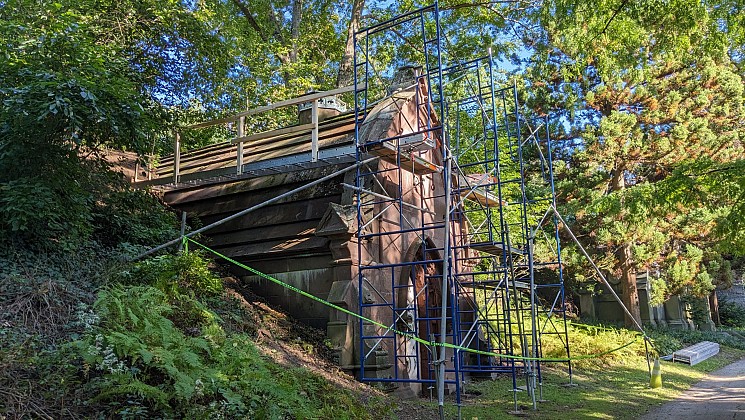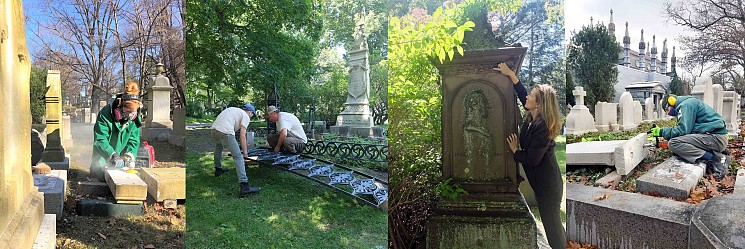Critical Restoration Need! The Scots’ Charitable Society Lot Fence

In the 1800s, Mount Auburn housed hundreds of iron fences, most of which have since been removed due to changing tastes at the turn of the 20th century. Of the 62 remaining iron fences at the cemetery, the Scots’ Charitable Society Lot Fence is perhaps the most significant.
At the intersection of Walnut and Fir Avenues, the Scots’ Charitable Society Lot Fence is one of the more ornate cast iron fences at Mount Auburn. Purchased in 1841 by the Scots’ Charitable Society for its members, this lot memorializes over 200 people of Scottish descent. The large fence designed by architect Theodore Voelkers is adorned with symbols of the heritage of the people buried in the lot, including the image of Saint Andrew, the patron saint of Scotland, as well as thistles, battle axes, rampant lions, and crests.
(more…)Lodge Family Tomb Fall 2023 Preservation Work

On a stroll around Auburn Lake you may have noticed the impressive Lodge family side-hill tomb on Oxalis Path. This brownstone tomb is the resting place of three U.S. Senators: Henry Cabot Lodge (1850-1924); his grandson Henry Cabot Lodge, Jr. (1902-1985) and his grandfather George Cabot (1752-1823). It was erected in 1867 constructed of Sandstone from Portland, CT, and has an entry door ornately carved from a single slab of marble. Sandstone is not a durable stone. There is evidence of repairs occurring numerous times over the past 156 years, most recently in 2004. The tomb is situated in a natural drainage path and is vulnerable to water damage and damage from salt that migrates with the water. Crystallization of salt along with freezing water inside the stone and joints has caused spalling, exfoliation and crumbling.
Preservation has begun on cleaning, assessing and repairing the Lodge mausoleum. Below are the three main focus areas for the next few weeks.
(more…)Preservation Underway on Veterans’ Monuments

Anna (Annie) Francis Kendall Freitag (1830-1905) became a nurse for the U.S. Army early in the Civil War. She first met her husband, Frederick (Fred) Daniel Freitag, when he was recovering from wounds at the hospital where she was stationed in 1862. Later on, Fred suffered a breakdown in 1886 and died two years after that. Annie’s pension file is a unique resource today: a rare primary source to specifically discuss a Civil War soldier’s mental health in addition to physical health, attributing both to his war wounds.
Originally from Virginia, Lieutenant Albert Allmand (1826-1857) entered the U.S. Navy in 1841. His career included service on eight ships, including helping patrol the African coast on the USS Cumberland to suppress the slave trade in 1857. He died soon after, when the ship was at the Navy Yard in Charlestown, MA. After his military funeral, he was buried at Mount Auburn in the Saint John’s Public Lot, a section for single grave interments (for people who had no use for, or could not afford, a large family lot). His marble headstone evokes his naval career with a relief of drapery, anchor, and cannon.
These are just a few of the many diverse stories of veterans commemorated at Mount Auburn, from throughout our nation’s history. This summer, our Preservation team has been working on much-needed treatment for the monuments to Freitag, Allmand, and eight other veterans from the pre-Civil War and Civil War period (see below for complete list). Most of their memorials include text documenting their service, like military rank or battles in which some died. Many also feature military-inspired carved imagery, making them an important, evocative funerary art form.
However, after years of outdoor exposure, these monuments urgently needed preservation to keep them intact for future generations. Thanks to a matching grant that we have received from the Mass. SHRAB Veterans’ Heritage program, our Preservation department has been able to give them the care that they need.
Preservation highlight: we had already identified that the monument to Full Private Jacob Merrifield (1842-1868) contains extensive inscription for its size, and it likely documents his military service, but it had become undecipherable over time. Thanks to the work that has already been completed so far, we are optimistic that one of our inscription expert volunteers will be able to decipher and record it after the full treatment is done – underscoring the importance of preservation to prevent the permanent loss of stories like his.
So far, our skilled team has cleaned all of the monuments, reset the foundations of six of them, and corrected a failed past repair from over two decades ago on one. The to-do list for the rest of the year includes follow-up cleaning (after six months) and stone consolidation work on all of the marble monuments. This treatment will stabilize the stones, preserve sculptural elements and inscriptions, and ensure the long-term survival of these important and threatened cultural artifacts.



Support our preservation team
Learn more at www.mountauburn.org/clendaniel-preservation-fund/.
Veterans’ monuments in this project
Albert Allmand (1826-1857), Lot 1736-337 Fir Avenue
Lieutenant, U.S. Navy, from 1841 until his death in 1857.
Gurdon S. Brown (1832-1889), Lot 1722 Cypress Avenue
First Lieutenant in Company A of the 30th Regiment, Massachusetts Volunteer Infantry (MVI) in the Civil War.
Jonathan Homer Cheney, Jr. (1844-1881), Lot 829 Fir Avenue
Private in Company E of the 44th Regiment, in the Civil War.
George H. Conant (1821-1863), Lot 1284 Geranium Path
First Lieutenant (previously First Sergeant and Second Lieutenant) in Company C of the 10th Iowa Volunteer Infantry in the Civil War. He was killed in action on November 25, 1863, on Missionary Ridge, TN, in the last of the three-day Battles of Chattanooga. The Union army victory there became known as “the death-knell of the Confederacy.” Conant’s remains were sent to Massachusetts to be buried with his family at Mount Auburn.
James J. Dow (1839-1864), Lot 3579 Saffron Path
Corporal in Company F of the 24th Regiment, MVI, which served with the Coast Division in the Civil War. Dow was killed in action in Deep Run, VA, and his remains were returned home to be buried with his family at Mount Auburn.
Anna (Annie) Francis Kendall Freitag (1830-1905), Lot 193 Ivy Path
U.S. Army Nurse from early in the Civil War until 1864.
Jacob C. Merrifield (1842-1868), Lot 3912 Cypress Avenue
Full Private in Company I of the 1st Maine Cavalry Regiment. He was initially rated as a Full Blacksmith, a key position in a cavalry company. Blacksmiths in the Civil War were responsible for shoeing horses (particularly important in cavalry regiments such as Merrifield’s) and repairing wagons and artillery equipment. Merrifield was later promoted to Full Private.
Samuel D. Phillips (1838-1862), 1259 Elder Path
Military Superintendent of Plantations during the Civil War. His role was part of the Port Royal Experiments, which were intended to help people who were newly freed from enslavement prepare for their independence. This included working land abandoned by plantation owners after the Union army captured the Sea Islands off the South Carolina coast in 1861, as well as education programs organized by Northern charity organizations.
Alexander Wilson (1814-1882), Lot 4777 Clethra Path
Private in Company B of the 42nd Regiment, MVI in the Civil War.
John A. Wilson (1843-1910), Lot 4777 Clethra Path
Artificer or skilled craftsman in Company C of the U. S. Army Corps of Engineers in the Civil War. The Corps of Engineers’ duties included planning and erecting defenses, constructing and destroying roads and bridges, placing and removing obstructions, conducting topographical surveys during campaigns, reconnoitering enemy works, and preparing and distributing accurate maps.
Support Preservation at Mount Auburn

The William C. Clendaniel Preservation Fund supports the specialized care that keeps our unique collections in good condition for years to come.
Mount Auburn Cemetery was designated a National Historic Landmark because of its exceptional historic landscape, which consists of both plants and built objects. When you visit, you are surrounded not only by nature but by the evolving history of funerary art in America – monuments, fences, stained glass, and other decorative items that families have chosen to remember their loved ones or that decorate our landscape and buildings.
Mount Auburn’s monuments feature the work of some of our country’s finest 19th-century sculptors, including Horatio Greenough, Edmonia Lewis, and Thomas Crawford. The stained glass in each of the chapels is the work of both Scottish and American craftsmen. More recent monuments reflect the work of contemporary artists and reflect the broadening demographics of the nation. Archival materials help tell the story of how these works of art were created. Taken together, all these elements document changes in commemorative art over the years, with evocative designs and inscriptions that help tell the stories of our residents and our national history. Made of marble, granite, slate, and even glass, this diverse collection is an essential part of our landscape’s beauty, educational value, and historical significance.
Because it is located outdoors, this collection of funerary art requires constant and specialized preservation to survive years of exposure to the elements. Acid rain and snow have already diminished many important details of marble monuments in particular, and high-level care is essential to protect all these items for future visitors.
To ensure that the Cemetery has the resources for this enormous but vital task, we have established the William C. Clendaniel Preservation Fund to support critical preservation work across the Cemetery. This endowed fund honors President Emeritus William C. (Bill) Clendaniel, who served as Mount Auburn’s President from 1988 until 2008.

Bill was a passionate advocate for preservation throughout his tenure. He recognized early on that Mount Auburn’s past approach of simply focusing on routine maintenance was not sufficient for the specialized needs of our collections. With that in mind, he worked to establish new policies that made preservation an essential part of the Cemetery’s mission, and increased the professionalism of the staff – as well as the budget – in the preservation department. His contributions continue to be felt throughout our landscape today.
Your gift to the William C. Clendaniel Preservation Fund gives our staff the resources they need to care for this vital collection for generations to come.
Our skilled preservation staff re-set, wash, repair, and repoint thousands of monuments and fences.
Our Curator of Historical Collections & Archives researches, provides documentation, and recommends preservation priorities.
Consulting sculpture conservators offer advanced expertise to preserve some of our most significant monuments.
Make a Gift Today!
Learn more about recent preservation highlights.
Gardner Mausoleum, 2017 – 2020
Learn more about Bill’s tenure at Mount Auburn.